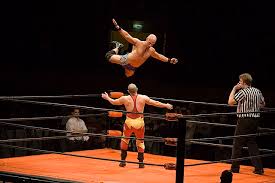Professional wrestling may be part entertainment and part sport, but there’s nothing fake about the physical toll it takes on the athletes who perform night after night. Behind the dramatic storylines, flying kicks, and high-impact slams lies a hidden world of intense preparation and carefully guarded secrets.
Unlike traditional sports, where training methods are often shared openly, pro wrestlers operate under a code of silence when it comes to how they prepare, recover, and protect themselves in the ring. Here’s a look into how these athletes keep their performance secrets under wraps and why it matters.
1. Behind the Curtain: Kayfabe and the Culture of Secrecy
One of the biggest reasons wrestlers keep their methods hidden is the concept of “kayfabe” the industry tradition of maintaining the illusion that everything in wrestling is real, even outside the ring.
This culture of performance extends to training. Wrestlers often downplay or conceal how they choreograph matches, manage pain, and practice stunts. To preserve the mystique, very few talk openly about how matches are rehearsed or how outcomes are predetermined even though these elements require tremendous physical and mental preparation.
2. Silent Strength: Conditioning That Stays Off Camera
Wrestlers train like elite athletes but most of that happens in private. Their workouts combine:
- Strength training (for slams and lifting opponents)
- Cardio conditioning (for endurance during 20–30 minute matches)
- Functional mobility (for safety and flexibility in moves)
Many wrestlers also practice ring-specific conditioning, like taking bumps (falling safely), running the ropes, and timing their landings skills that aren’t typically shown to fans or even documented on social media.
Why so secret? Because the more real the performance looks, the more impact it has. Wrestlers go to great lengths to hide the mechanics behind the magic.
3. Pain Management: A Code of Silence
Another closely guarded area is injury prevention and pain management. Wrestlers absorb more impact in a week than most athletes do in a season. They manage pain through:
- Cryotherapy
- Massage and chiropractic care
- Deep stretching and yoga
- Custom rehab programs
But they rarely speak openly about injuries unless they’re written into a storyline. Protecting the illusion of invincibility is a key part of the job even when it means hiding the toll from fans and sometimes even from peers.
4. Mental Preparation: Psychology Behind the Performance
Wrestling isn’t just about physical prowess it’s also about crowd control, timing, and storytelling. Wrestlers rehearse promos (spoken segments), study audience psychology, and learn how to pace a match for maximum drama. This training is typically passed down through veterans, not taught in public forums.
The mental edge wrestlers develop knowing when to slow down, sell a move, or build momentum is one of the most valuable “trade secrets” in the industry.
5. Keeping the Illusion Alive
Even in today’s digital age, where fans can find behind-the-scenes clips and breakdowns, many wrestlers and promotions go to great lengths to protect the mystique. Some wrestlers maintain separate social media personas. Others avoid doing interviews that might blur the lines between character and performer.
The goal? To ensure that when fans tune in, they still believe even just a little that what they’re seeing could be real.
Final Thoughts
Professional wrestlers are part athlete, part actor, and part stunt performer but 100% committed to protecting the art form they love. Their training regimens, recovery methods, and in-ring techniques are as advanced and demanding as any professional sport. The only difference? Most of it happens in the shadows.
By keeping their performance secrets guarded, wrestlers preserve the spectacle, protect themselves, and honor the long-standing traditions of an industry built on mystery, illusion, and incredible physical talent.

